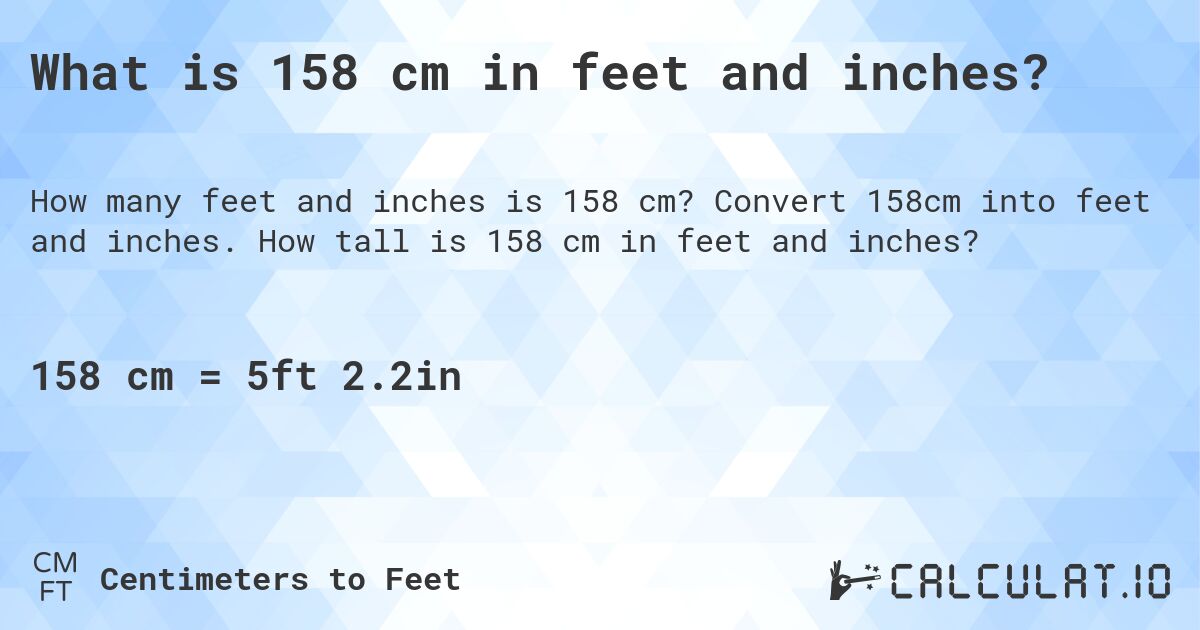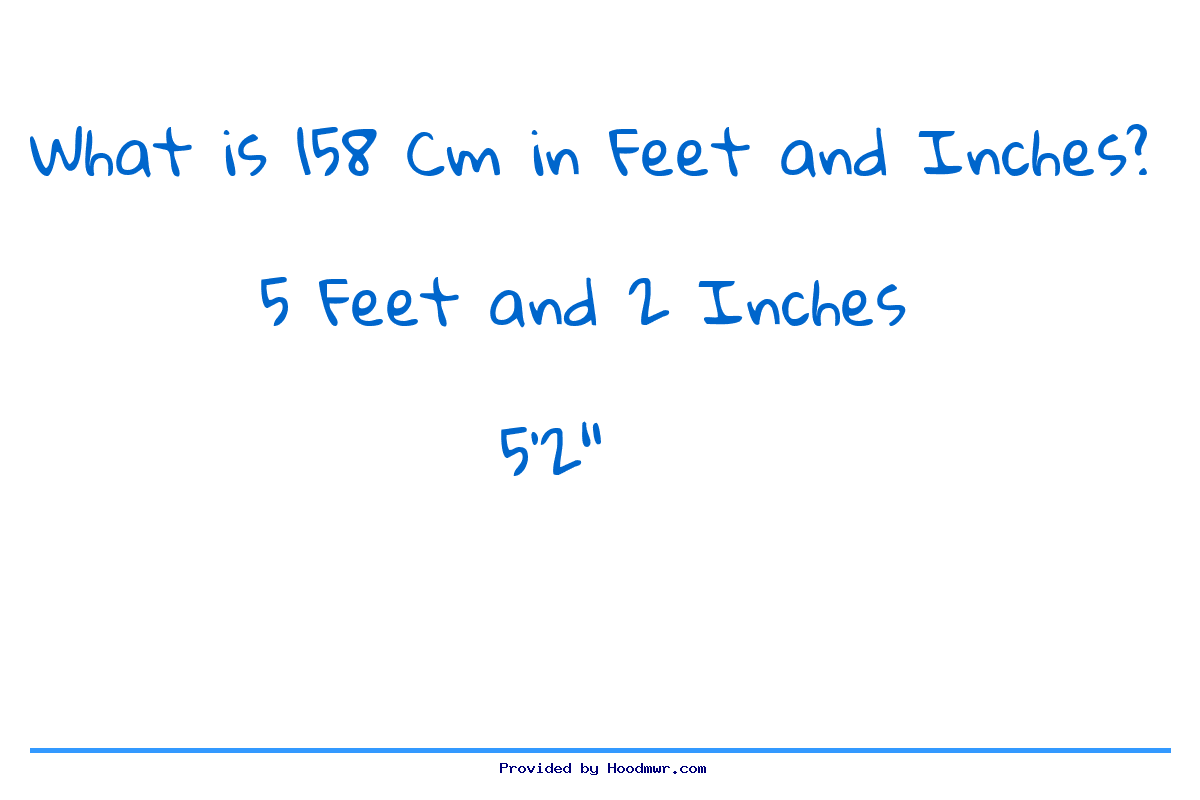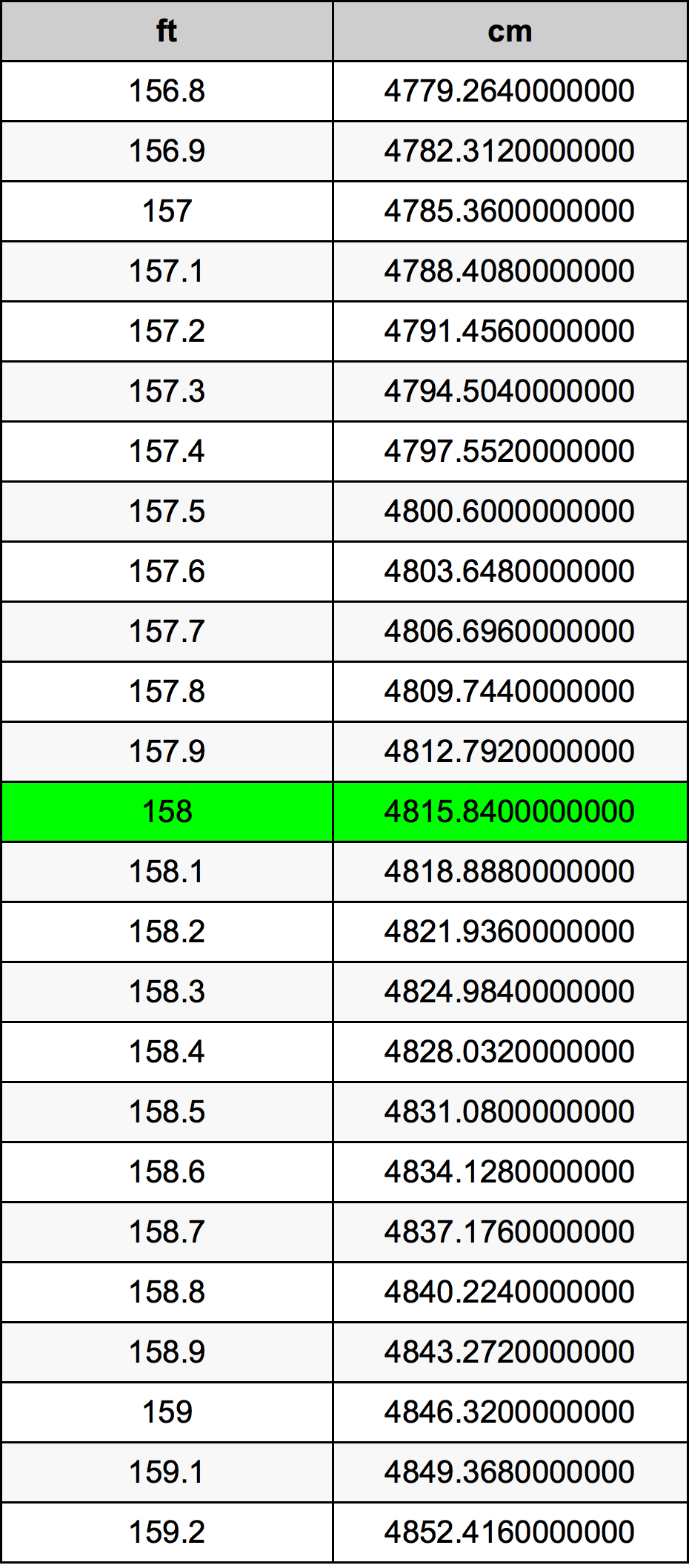Ever found yourself wondering just how tall someone who's 158.5 cm actually is in feet and inches? It's a question that bridges the gap between metric precision and the more familiar imperial system, and understanding the conversion is more straightforward than you might think.
Navigating the world of measurements often requires juggling different units. Centimeters, a staple of the metric system, provide a precise way to denote height or length. However, in many parts of the world, particularly in the United States, the imperial system, with its feet and inches, remains the standard. This necessitates a clear understanding of how to convert between these systems, especially when discussing personal height or spatial dimensions. The need to convert 158 cm to feet arises frequently in various contexts, from medical records and construction projects to simply understanding someone's height in a relatable way. In essence, knowing how to translate between these units offers a practical advantage in a globalized world.
| Category | Details |
|---|---|
| Conversion: | 158 Centimeters to Feet and Inches |
| Centimeters (cm): | 158 cm |
| Feet (ft): | Approximately 5 feet |
| Inches (in): | Approximately 2.2 inches |
| Total Equivalent: | 5 ft 2.2 in |
| Conversion Factor (cm to ft): | 1 cm 0.0328084 ft |
| Conversion Factor (cm to in): | 1 cm 0.393701 in |
| Calculation: | (158 cm 0.0328084 ft/cm) 5.1837 ft (0.1837 ft 12 in/ft) 2.2044 in |
| Common Uses: | Estimating height, construction measurements, tailoring |
| Further Information: | Google Search - Convert 158 cm to feet and inches |
So, how exactly do we translate 158 centimeters into the more familiar feet and inches? The answer lies in understanding the relationship between these units. One centimeter is approximately equal to 0.0328084 feet. This is the key conversion factor that allows us to move between the metric and imperial systems. Alternatively, 1 centimeter equates to roughly 0.393701 inches, providing a direct route to converting centimeters to inches.
- Marie Dee Husband Family Life Unveiling The Social Media Star
- Free Remote Iot Platform Ssh For Raspberry Pi Download Now
To convert 158 cm to feet, we multiply 158 by the conversion factor 0.0328084. This gives us approximately 5.1837 feet. Since we typically express height in a combination of feet and inches, we need to separate the whole number (5 feet) from the decimal portion (0.1837 feet). The decimal portion represents the fraction of a foot that needs to be converted into inches.
To convert the decimal portion of a foot into inches, we multiply it by 12, as there are 12 inches in a foot. So, 0.1837 feet multiplied by 12 inches/foot equals approximately 2.2044 inches. Therefore, 158 centimeters is approximately equal to 5 feet and 2.2 inches. This conversion provides a clear and easily understandable equivalent in the imperial system.
There are various ways to perform this conversion. One common approach involves using online calculators specifically designed for unit conversions. These tools often provide instant results, eliminating the need for manual calculations. Another method is to use a conversion table, which lists common centimeter-to-feet-and-inches equivalents. These tables are particularly useful for quick estimations and avoiding the need for real-time calculations. Regardless of the method, the underlying principle remains the same: applying the appropriate conversion factor to translate between centimeters and feet and inches.
- Jason Kylie Kelce Welcome Baby Finnley Details Updates
- Raspberry Pi Ssh Remote Access Free Download Guide
It's worth noting that different online tools and calculators might yield slightly different results due to rounding differences. For instance, some calculators might round 158 cm to 5 feet and 2.205 inches, while others might round it to 5 feet and 2.2 inches. These variations are usually negligible and do not significantly impact the overall understanding of the equivalent height. The important thing is to understand the general process and be aware of potential rounding differences.
The ability to convert between centimeters and feet and inches is not just a mathematical exercise; it has practical implications in various fields. In healthcare, medical professionals often need to convert patient heights from centimeters to feet and inches for record-keeping and treatment planning. In construction and architecture, precise measurements are crucial, and the ability to convert between metric and imperial units ensures accuracy and compatibility. Similarly, in the fashion industry, understanding measurements in both systems is essential for creating well-fitting garments. Even in everyday situations, such as buying furniture or decorating a home, the ability to convert between these units can be incredibly helpful.
Understanding the relationship between meters, feet, and inches provides a broader perspective on measurement systems. One meter is equivalent to approximately 3.28 feet. Since one foot is exactly 12 inches, we can also say that one meter is roughly 39.37 inches. This knowledge can be useful when dealing with larger measurements or when needing to estimate heights or distances quickly.
Furthermore, understanding the historical context of these measurement systems can shed light on their prevalence and usage. The metric system, with its base-10 structure, is widely used in scientific and international contexts due to its simplicity and ease of use. The imperial system, on the other hand, has its roots in historical practices and is still prevalent in certain countries, including the United States. Recognizing the historical and cultural factors behind these systems can foster a better understanding of why conversions are often necessary.
While the conversion factor between centimeters and feet is relatively straightforward, it's important to consider the context in which the conversion is being used. For instance, if precision is paramount, it's crucial to use a conversion factor with a higher degree of accuracy. In such cases, using a conversion factor with more decimal places can minimize rounding errors and ensure greater accuracy. Conversely, if a rough estimate is sufficient, a simplified conversion factor might suffice.
In addition to online calculators and conversion tables, there are various apps and software programs that can assist with unit conversions. These tools often provide a wide range of conversion options, including conversions between different units of length, weight, volume, and temperature. They can be particularly useful for individuals who frequently work with different measurement systems.
Moreover, the ability to perform unit conversions can be a valuable skill in educational settings. Teaching students how to convert between metric and imperial units can enhance their understanding of measurement concepts and improve their problem-solving abilities. It can also help them develop a greater appreciation for the different systems used around the world.
In conclusion, converting 158 centimeters to feet and inches is a relatively simple process that involves applying the appropriate conversion factor. Whether you're using an online calculator, a conversion table, or performing the calculation manually, understanding the underlying principles is key. This skill has practical applications in various fields, from healthcare and construction to fashion and everyday life. By mastering this conversion, you can navigate the world of measurements with greater confidence and ease.
Let's delve a bit deeper into the nuances of converting centimeters to feet and inches. While the basic conversion factor remains constant, there are subtle variations in how the final result is expressed. For instance, some individuals might prefer to express the inch component as a decimal, while others might prefer to round it to the nearest whole number or fraction. The choice often depends on the level of precision required and the intended audience.
Consider the example of expressing 158 centimeters in feet and inches. As we previously determined, 158 cm is approximately equal to 5 feet and 2.2 inches. However, we could also express this as 5 feet and 2 1/5 inches, or even as 5 feet and 2 1/4 inches if we're willing to accept a slightly lower degree of precision. The key is to choose the representation that best suits the context and the needs of the situation.
Furthermore, it's important to be aware of the potential for ambiguity when expressing measurements in feet and inches. For example, the notation 5'2" is commonly used to represent 5 feet and 2 inches. However, this notation can sometimes be misinterpreted, especially in international contexts where different conventions might be used. To avoid confusion, it's always best to clearly indicate the units being used, such as "5 feet, 2 inches" or "5 ft 2 in."
Another aspect to consider is the impact of significant figures on the accuracy of the conversion. Significant figures refer to the digits in a number that carry meaningful information about its precision. When converting between centimeters and feet and inches, it's important to maintain an appropriate number of significant figures to avoid introducing unnecessary errors. For instance, if the original measurement of 158 cm is only accurate to three significant figures, it would be misleading to express the converted value with more than three significant figures. In such cases, rounding the converted value to the appropriate number of significant figures is essential.
In addition to the direct conversion from centimeters to feet and inches, there are also indirect methods that can be used. For example, one could first convert centimeters to meters and then convert meters to feet and inches. This approach might be useful if you already have a conversion factor for centimeters to meters or meters to feet and inches readily available. Alternatively, you could use a combination of online calculators and conversion tables to perform the conversion in multiple steps. The key is to choose the method that is most convenient and efficient for your particular situation.
The use of technology has significantly simplified the process of unit conversion. With the advent of smartphones and tablets, it's now possible to perform conversions on the go using dedicated apps or web-based tools. These apps often provide a wide range of conversion options and can be customized to suit individual preferences. They can also store frequently used conversions for quick access. Whether you're a student, a professional, or simply someone who needs to perform unit conversions occasionally, these tools can be invaluable.
Beyond the practical applications of unit conversion, there are also interesting mathematical concepts that underpin the process. The conversion factors between different units are essentially ratios that express the relationship between those units. Understanding these ratios can provide insights into the underlying structure of the measurement systems and their interrelationships. For instance, the fact that one inch is exactly 2.54 centimeters is a fundamental relationship that connects the metric and imperial systems.
Furthermore, the process of unit conversion can be viewed as a form of dimensional analysis. Dimensional analysis involves tracking the units of measurement throughout a calculation to ensure that the final result has the correct units. This technique can be particularly useful in complex calculations involving multiple units and conversions. By carefully tracking the units, you can avoid making errors and ensure that your results are meaningful.
In summary, the conversion of 158 centimeters to feet and inches is a relatively straightforward process that has practical applications in various fields. By understanding the underlying principles and using the appropriate tools and techniques, you can perform this conversion with confidence and accuracy. Whether you're a student, a professional, or simply someone who needs to convert between measurement systems occasionally, mastering this skill can be invaluable.
Let's explore some additional scenarios where the conversion of centimeters to feet and inches might be particularly relevant. Imagine you're shopping for a new rug and the dimensions are listed in centimeters. To visualize the rug's size in your living room, you'll need to convert those centimeters to feet and inches. This will help you determine if the rug will fit properly and complement your existing furniture.
Similarly, if you're planning a DIY home improvement project, you might encounter measurements in both metric and imperial units. For example, you might need to convert the height of a wall from centimeters to feet and inches to determine how much wallpaper or paint you'll need. Or you might need to convert the dimensions of a piece of lumber from inches to centimeters to ensure it fits properly in your project.
In the field of sports, the conversion of centimeters to feet and inches is often used to describe the height of athletes. For instance, a basketball player might be listed as being 200 cm tall, but this is often translated to 6 feet and 7 inches for easier understanding by fans in countries that use the imperial system. This allows fans to better visualize the athlete's height and compare it to others.
In the medical field, the conversion of centimeters to feet and inches is essential for accurately recording patient heights and calculating body mass index (BMI). BMI is a measure of body fat based on height and weight, and it's used to assess an individual's risk of developing certain health conditions. Accurate height measurements are crucial for calculating BMI accurately.
The conversion between centimeters and feet and inches also extends to the realm of technology. For example, the screen size of a television or monitor is often measured in inches, while the physical dimensions of the device might be listed in centimeters. Understanding the relationship between these units can help you choose the right size display for your needs.
Moreover, the ability to convert between centimeters and feet and inches can be useful when traveling to different countries. Different countries use different measurement systems, and being able to convert between them can help you understand distances, sizes, and other measurements more easily. This can make your travels more enjoyable and less confusing.
In addition to the direct conversion from centimeters to feet and inches, it's also helpful to understand the relationship between other units of measurement. For example, one inch is equal to 2.54 centimeters, one foot is equal to 30.48 centimeters, and one meter is equal to 100 centimeters. Knowing these relationships can help you perform conversions more quickly and easily.
The use of technology has made unit conversion easier than ever before. There are numerous online calculators and mobile apps that can perform conversions instantly and accurately. These tools can save you time and effort, especially when dealing with complex conversions or multiple units.
Furthermore, the ability to perform unit conversions can be a valuable skill in various professional fields. Engineers, architects, designers, and scientists all need to be able to convert between different units of measurement regularly. Mastering this skill can improve your efficiency and accuracy in your work.
In conclusion, the conversion of 158 centimeters to feet and inches is a fundamental skill that has practical applications in various aspects of life. Whether you're shopping, traveling, working, or simply trying to understand the world around you, the ability to convert between different units of measurement can be invaluable.



Detail Author:
- Name : Jany Yundt
- Username : nicklaus13
- Email : marina.harris@yahoo.com
- Birthdate : 1982-11-13
- Address : 523 Dietrich Roads Suite 329 Kunzefurt, UT 86419-1126
- Phone : +1.443.336.5552
- Company : Reichert Group
- Job : Railroad Inspector
- Bio : Libero enim et reiciendis excepturi quia eos. Maiores a laboriosam et quos maxime aut ea. Nostrum unde sunt officia maxime facere assumenda quaerat.
Socials
linkedin:
- url : https://linkedin.com/in/ressie.jacobson
- username : ressie.jacobson
- bio : Est vero mollitia voluptatem vitae aut quam.
- followers : 4372
- following : 987
twitter:
- url : https://twitter.com/rjacobson
- username : rjacobson
- bio : Mollitia voluptas et ut distinctio. In nulla a et earum fugit iusto accusamus. Enim qui aut distinctio dolores. Sequi doloribus unde labore.
- followers : 1622
- following : 1145
facebook:
- url : https://facebook.com/ressie4000
- username : ressie4000
- bio : Fugiat labore corporis alias. Et accusamus voluptatibus magni laborum.
- followers : 2514
- following : 1309